Ireland faces challenges in meeting waste targets
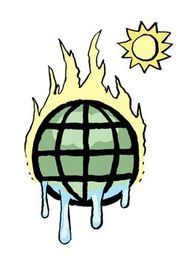
The latest report from the EPA reveals a number of worrying trends. Waste generation in Ireland continues to increase, making it difficult to maintain or increase recycling rates. Ireland is in danger of missing the 2025 EU municipal waste and plastic packaging recycling targets. Ireland’s waste generation continues to increase in line with economic growth, indicating that we have not succeeded in moving from the linear economic model to a circular economic model. In addition, Ireland remains reliant on export markets for the treatment of specific waste streams including residual municipal wastes, hazardous waste, packaging waste and biowastes.
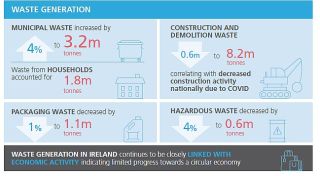
Ireland is generating too much waste, but this is not just a waste management problem. There are wider climate and environmental impacts of increasing waste such as the land-use, resources, chemicals and the energy involved in the creation of products that become waste.
Key waste trends 2020:
- Waste Electrical and Electronic Equipment (WEEE) collection rate is 60% in 2020 missing the new collection target of 65%.
- The amount of municipal waste recycled has increased by 11% since 2016, but total waste generated also increased by 11%, so the recycling rate has stagnated at 41%.
- Household waste has grown by 27% equivalent to over 400,000 tonnes in the last five years. Our kerbside system is key to improving our recycling rate with focused efforts on reducing the quantities of residual waste collected needed.
- Food waste across the entire supply chain has been calculated to be over 770,000 tonnes. The challenge to reduce this amount to the target level of 50% is significant.
- For the fourth year in a row the total packaging waste generated in Ireland exceed 1m tonnes. The overall packaging recycling rate is 62% with a target of 65% to be met by 2025.
- Construction waste is the largest waste stream in the state amounting to over 8.2 million tonnes in 2020. Soil and stone is the largest waste fraction of this stream, accounting for 82% of the stream, and can be avoided through the greater use of the by- product regulation.
- Ireland remained heavily reliant on export for the treatment of a number of key waste streams in 2020; 27% of biodegradable waste, 39% of municipal waste, 55% of hazardous waste, 50% of packaging waste and almost all WEEE were exported for the final treatment step. However, 70% of WEEE pre-treatment was carried out in Ireland.
- In 2020, Covid restrictions impacted several waste streams, including:
- Household waste increased by 18%, due to changes in householder behaviours.
- Bulky skip waste increased by 60,000 tonnes due to domestic clear-outs.
- Construction and demolition (C&D) waste decreased by 7%, due to reduced C&D activity.
- The number of cars scrapped decreased by 21%.
- The amount of telecommunications equipment including screens placed on the Irish market increased by around 30% as people spent more time using screens for communication, work, education and leisure activities.
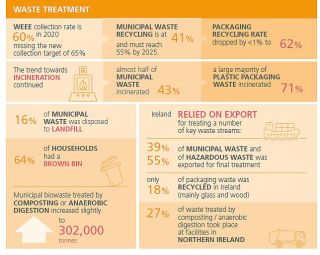
Ireland’s waste generation continues to increase in line with economic growth, indicating that we have not succeeded in moving from the linear economic model of “take, make, use, and waste”. We need to move to circular economy where resources are re-used, repaired or recycled as much as possible, and the generation of waste is minimised. A circular economy is one that is based on less waste and more reuse of materials; these trends show Ireland is going in the wrong direction. Our rising levels of waste are unsustainable and immediate steps must be taken to address these trends. Systemic change is needed across all economic sectors to shift the focus to designing out and reducing waste and promoting reuse and recycling.
Ireland has made strides in many areas of waste management, the latest EPA data show that further improvements are needed. Ireland has not yet succeeded in breaking the link between economic growth, consumption levels and waste generation and is missing valuable opportunities to maximise the beneficial and efficient use of waste materials. The latest waste data underscore the need for Ireland to do far more to prevent waste, improve levels of reuse and recycling and transition to a circular economy. The circularity rate or circular material use rate is a measure of material reused, recycled and recovered and fed back into the economy. A higher circularity rate means more secondary materials are in use replacing primary raw materials, thus reducing the environmental impacts of extracting primary material. Circularity in Ireland currently lags behind its EU peers. In 2020, Ireland’s circularity rate was 1.8%, whilst the average circularity rate in the EU was 12.8%
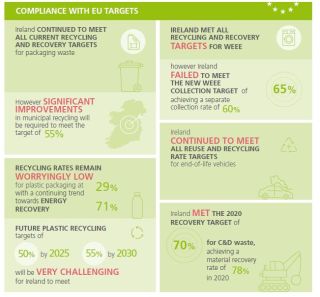
Ireland is continuing to meet many of its current EU targets. However, targets for 2025 and beyond are extremely challenging. Our increasing levels of waste are undoing our efforts to recycle more, and our rate of recycling has stagnated. For example:
- Municipal waste recycling rate was 41 per cent in 2020, however it must reach 55 per cent by 2025.
- Plastic packaging recycling rate was 29 per cent in 2020, however it must reach 50 per cent in 2025.
Disposal to landfill has fallen sharply in Ireland over the past decade; a welcome development since this is the least desirable option in the waste management hierarchy. The municipal waste landfill rate in 2020 was 16 per cent, down from 58 per cent in 2010. The share of municipal waste sent for energy recovery increased from four per cent in 2010, to 42 per cent in 2020. Ireland remains heavily reliant on export for the treatment of a number of key waste streams, pointing to some significant waste infrastructure deficits and missed opportunities to foster a circular economy. Exported waste for treatment in 2020 included:
- 27 per cent of biodegradable waste;
- 39 per cent of municipal waste;
- 55 per cent of hazardous waste;
- 50 per cent of packaging waste; and
- almost all WEEE was exported for the final treatment step.
Targets for 2025 and beyond will be challenging for Ireland to meet.
- Municipal waste recycling rate was 41 per cent in 2020, the same level as 2016, however the recycling rate target must reach 55 per cent by 2025.
- Plastic packaging recycling rates remain worryingly low at 29 per cent (up marginally from 28 per cent in 2019), however this increases to 50 percent in 2025.
- The overall packaging recycling rate remained unchanged at 62 per cent, surpassing the current target of 55 per cent, however this increases to 65 per cent in 2025.
- WEEE collection rate was 60 per cent in 2020, missing the new collection target of 65 per cent.
Our rising levels of waste are unsustainable and are threatening Ireland’s achievement of EU recycling targets. We urgently need mandatory incentivised charging for the collection of non-household (commercial) municipal waste. We need to increase the rollout of brown bins, collect more food waste separately and increase the capture of plastic packaging for recycling at collection and processing stages.
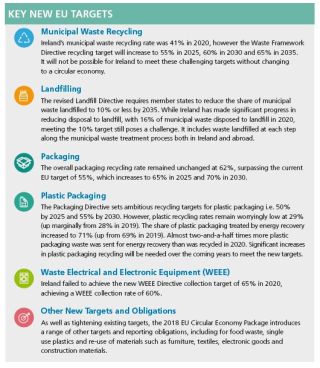
Actions required in 2023
In order to meet 2025 targets, Ireland must progress actions to meet the targets set out in the Circular Economy Action Plan. The EPA has outlined the following actions as essential in 2023 to reduce waste generation.
There is an urgent need to increase the municipal recycling rate which is not on track to meet the 2025 targets. Key actions include:
- Introduction of mandatory incentivised charging for the collection of non-household municipal waste;
- Rollout of brown bins to rural areas with no population exemptions and businesses who are currently not on a collection service;
- Targeted and co-ordinated awareness and education campaigns focused on improving the capture of food waste from businesses and households;
- Targeted enforcement campaigns to lower contamination rates in the recyclable bin;
- A review of the effectiveness of the waste charging system to householders to incentivise and reward waste reduction and recycling.
Targeted financial, regulatory and awareness measures are urgently needed to drive a step change improvement in plastic recycling in order to meet the 2025 targets. Key actions include:
- Accelerated implementation and monitoring (of the impact) of eco fee modulation for the production of high-quality recyclable plastic packaging;
- Setting recycling subsidies to incentivise the collection of plastic packaging rewarding waste collectors to improve the rates of recycling of these materials;
- Examining the potential for fiscal measures to incentivise increased manufacturing and use of reusable plastic packaging and other packaging products;
- Targeted and co-ordinated awareness and education campaigns on improving the separate capture of plastic packaging materials from businesses and households.
By addressing waste infrastructure deficits, Ireland can develop circular economy opportunities and reduce the emissions associated with transporting waste over long distances. Key actions include:
- Completion of the national waste treatment capacity register to allow for monitoring and tracking of the capacity market;
- Assessment of the biological treatment capacity and current market to improve Ireland’s self-sufficiency and minimise the loss of biowaste resources to export markets;
- Complete business continuity and contingency assessment for the management of hazardous wastes;
- Identify opportunities to develop circular economy solutions and build resilience for the recovery of non-hazardous and hazardous waste;
- Progress work on the national contingency treatment facility.